|
THE tendency of
population is to centralize; and centralization of population means
influence. We think therefore that a short
DESCRIPTION OF THE COUNTY TOWN, as the centre of County influence, would
not he altogether out of place. The harbour, which is two miles long,
and three quarters broad, is formed by two rocky ridges, which run
nearly parallel. The town occupies the rising land which forms the
Western slope of the Eastern ridge ; and consists of several long’
streets lying nearly due North and South, which are crossed by numerous
others shorter running up from the harbour, and intersecting the longer
ones' at nearly right angles. The three, principal, are Water Street,
Main Street, and William Street. Water Street as its name indicates, is
nearest to, and runs approximately parallel with the harbour. On it, are
the principal manufacturing industries, general warehouses and stores.
Main Street is in some sense, as the name suggests, the leading
thoroughfare. On it are the principal offices, stores, banks and other
places of business. This street is nearly two miles long; and the
central part of it is the kernel of the business section of the Town.
William Street, the most Easterly principal thoroughfare, is a fine
straight street, and promises to be the most desirable part of the Town
for private residences.
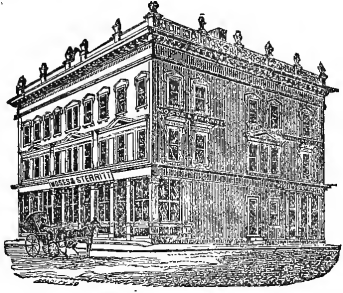
Nothing at first, or
for thirty years, gave any distinct intimation of the future importance
of the Town, where it now stands. The “Town Point” at Chebogue, is one,
among other proofs, of man’s intention, that the present Town should be
a subordinate settlement. And so it long continued. In 1764, from
Haskill’s Brook to Hibbard’s Corner, which was the main part of the
settlement, there were but ten houses, and seventy-three souls. In 1787,
more than twenty years afterwards, there were hut seventeen houses in
the same district, and one hundred and eight souls. And looking the
other way, towards Milton, from the Brook, even as late as the year
1793, there were hut ten houses to the Mill. Or again, from Milton to
the corner of Wyman’s road in the same year, there were on the main
road, hut twenty-eight houses. And even as late as 1805, there were only
thirty-eight houses, with about two hundred and twenty souls within this
whole distance. Such was Yarmouth’s day of small things, even after
upwards of forty years had elapsed. We now look around, and . many of
those, who from the circumstance of having been born and reared in the
Town or its vicinity, might have been fairly presumed to have kept pace
with its onward march, are the least ahle to fully realize what progress
has been made. A comparative stranger under the circumstances, becomes a
more appreciative observer. In the younger days of old inhabitants,
school building, church building, and the like, were state occasions.
Now, churches and schools are built, banks are established, insurance
offices are opened, new companies for all kinds of enterprize are
formed, and unless directly concerned we may he none the wiser.
The primitive Cape Forchue meeting house of 1784, with its unglazed
windows, seatless interior, the whole being guiltless of paint, has
given place to ten PLACES OF WORSHIP within less than two miles, which,
for the more part, are at once spacious, comfortable, and convenient:
features however, not more salient. than the marked improvement in the
styles of architecture introduced.
Beginning at the South end and proceeding Northerly from the New
Episcopal Sunday School House on the site of the old Church, a building
which has given place to the most substantial edifice of that body in
the Province, we can observe most conveniently the principal features of
the Town.
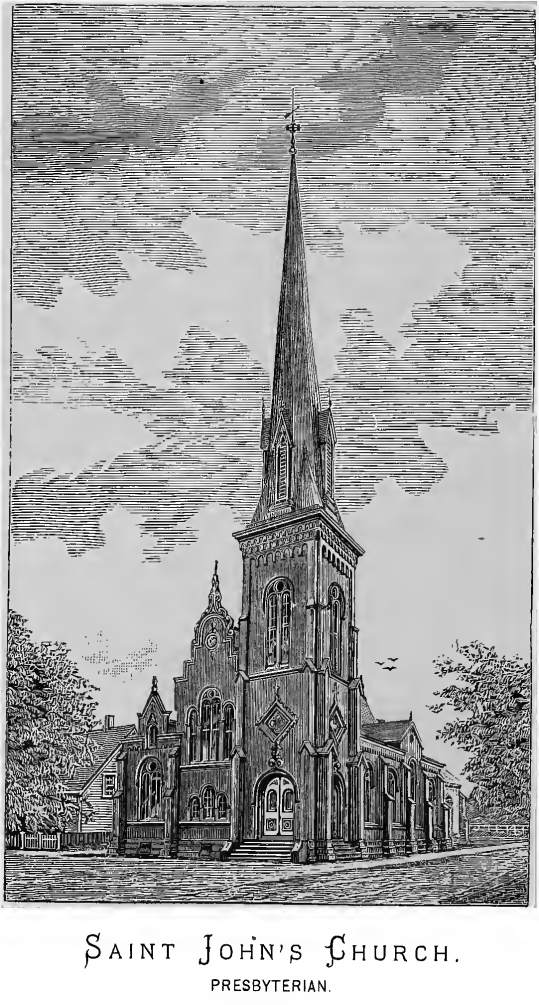
A few hundred yards to
the Eastward on Argyle street, stands the Temple Church erected in the
interests of the Baptist body, in 1870. This structure is built partly
in the earlier or transition period of Gothic architecture, and partly
in the perpendicular style. The severer views and traditions of those
who love plainness are somewhat shocked in this building; the extent and
variety of the interior colouring being, without any doubt, unequalled
by any other building in the Town. Next in order, after we return to the
Main Street, is the “Providence Church,” which took the place of the
former Methodist Chapel of 1825; and, although it can lay no claim to
architectural decision, it is a great advance on its predecessor: whilst
a little to the West of it, stands the Roman Catholic Chapel, simple in
structure, but correct in style, which was erected in 1862 on the site
of one smaller. Passing by the Episcopal Church on William Street, which
has been elsewhere referred to, and glancing towards Cliff Street, we
see that the Presbyterians are nearly ready to take possession of new
Saint John’s, of which we insert a view. This building which is in the
Romanesque style, and which will be capable of meeting all the wants of
the congregation, takes the place of that which was erected in 1841.
This body of Christians has been served by the Rev. George Christie, for
more than a quarter of a century; he having assumed the pastoral charge
in 1849, as successor to the late Mr. Ross, who lives in the memory of
those who knew him, as a faithful pastor and an able preacher. We nest
come to what was the old Cape Forchue meeting house of 17&L But the
characteristic great porch which stood in front of it, has gone; and
what between alterations in length and height, and the addition of a
spire, and having been made otherwise, as far as practicable, abreast of
modern ideas, its character is completely changed. Before the year 1800,
the house was the property of the Congregationalists; but in that year,
in the language of the Chronicler of ‘the Life and Times of Harris
Harding,’ “Mr. Harding’s friends literally stole an entrance into the
“house; from which they were not afterwards ejected.” The very day and
occasion are yet fresh in the memory of one, perhaps the only one, who
was present and who is still living, and whose graphic description is
worthy of record in her own words:—
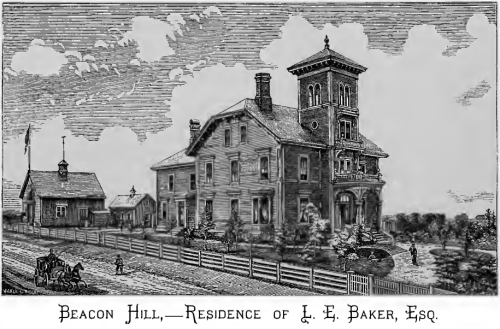
“On a Sunday morning in
the year 1800,1 went up to the new meeting house at Milton. It being a
fine summer day a large congregation had collected. The building was
small and unfinished; a carpenter’s bench serving for a pulpit, with the
aid of a chair in front of the preacher, The men eat on the south side,
the women on the north. After Mr. Harding had proceeded a short time
with the service, he said think this place is too small for us, let us
adjourn to the old meeting house of course, I came down with the crowd,
men women and children, a few on horseback, the rest on foot, with Mr.
Harding at the head; but when they reached their destination the doors
were locked. What was to be done? ‘Where there’s will, there is
generally a way.’ One of the number ran round to the back of the
building, threw up a window, jumped in and unbolted the door, which
being a double one, at once flew open, when all rushed in, and a meeting
was held. The proprietors of this meeting house were very much opposed
to the movement, as it was justly their property. One of them would not
even allow the remains of his father to repose in the burying ground
attached to it, but had them removed to his own farm at Chehogue.”
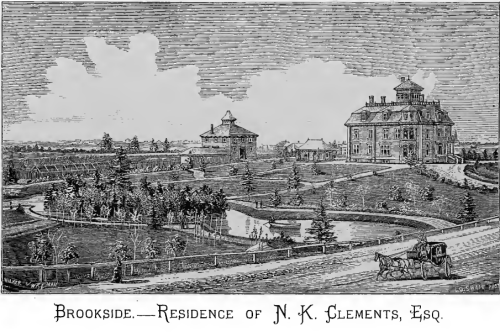
The first person
interred in the old graveyard below the meeting house, was Mrs. Brown,
the mother of old Mr. Benj. Brown, about the year 1766: whilst in the
upper, or eastern graveyard, the first interred was Mr. Zachariah
Corning.
At some distance to the northward stands the Tabernacle Church,
noteworthy as embodying more correct details of ecclesiastical
architecture, when it was built in 1850, under the energetic ministry of
the Rev. F. Tomkins, than any other similar structure in the Province.
As we approach Milton, the name of which (“Mill Town”) gives its own
history, where in 1790, thirty years after settlement, there were not
more than five houses, the spires of the Wesley and. the Baptist places
of worship tell of increase in numbers and wealth. The former was built
in 1864, and supplanted the original structure, which has been since
converted into a temperance hall; whilst the latter was finished in
1873.
Similarly, the principal SCHOOL BUILDINGS in the three sections, into
which the Town is divided, standing out with marked prominence on the
ridge of high land which forms the crest of the Town, tell their own
tale. Before 1836, in which year the building long known as the Academy,
was raised by the Yakmouth Education Society, there was no school
edifice in the Town worthy of the name; and now, the unsolicited
expression of observant visitors is, that those structures vie in every
respect with the foremost kindred institutions on the Continent. The
building known as the Seminaby, which is partly used as a High School,
and partly rented by the Governors to the Trustees of the central
section for Common School purposes, is as noble and harmonious in design
as the projected institution was spirited in its inception. The Seminary
having been raised before the other sections had built, suggested a
model, which to some extent has been followed with excellent effect.
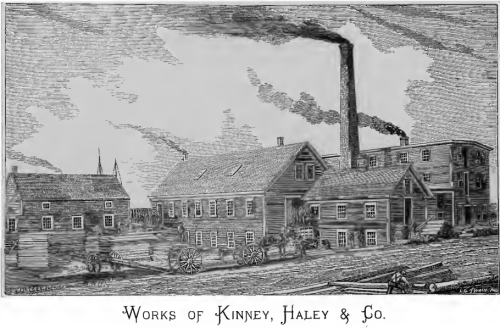
Having thus briefly
noticed the Churches and School Buildings in the Town, we may be
reasonably expected to make some reference to
PRIVATE RESIDENCES.
Living descendants of the earliest comers can yet tell us tales which
they have heard in their youth, of rude huts, and of chinks between the
logs stuffed with moss, who themselves live as merchant princes in
palatial homes. Such costly buildings are not few, and their number as
well as their size and completeness, excite the admiration, if not the
envy of all who visit them. To refer to individual cases seems almost
invidious, but in this connection the establishments of Samuel Killam,
Esq. and J. K. Ryerson, Esq. are particularly worthy of mention. And
here the reader will find a view of the residence of L. E. Baker, Esq.,
as well as of that of N. K. Clements, Esq., who is elsewhere referred
to, with respect to our steam navigation; and whose spirited connection
with the origin and progress of the Tabernacle Church, the Seminary, and
other public institutions and conveniences, is too well understood to
call for any eulogium.
If we ask what agencies represent the powers that call those churches,
schools, and residences into being, we point to numerous and increasing
Insurance Offices, Banks •and manufacturing industries. When the “Polly”
was lost in 1777, there were no Insurance Offices on which to fall back
for loss of vessel, freight or cargo; and it is a note-worthy
circumstance that the first Marine Insurance Broker in Yarmouth,—Mr.
Benjamin Barnard—was the nephew of John, who was captain and owner of
the first vessel which was lost out of the port. Now there are the
“Marine,” the “Acadian,” the “Commercial,” the “Atlantic,” the
“Pacific,” and the “Oriental.” In those six offices nearly all the
shipping in the port is insured; and the aggregate of their annual risks
is upwards of $6,000,000; whilst the premiums paid to insure that amount
nearly reach $500,000.
“Pay and go” was the necessary principle of the Hamlet Fathers. And
indeed till 1889, when an Agency of the Bank of Nova Scotia was
established, there were none of the privileges of that kind of
institution available. This Agency continued for] more than a quarter of
a century to be the only accommodation of the kind—first under the joint
management of the Hon. James Bond and the Hon. Stayley Brown; and now
under that of our respected citizen James Murray, Esq. The Bane of
Yarmouth which was incorporated in 1859, and which commenced operations
in 1865; and later still, in 1869 the Exchange Bank, have sprung into
existence, with a paid up capital of between $600,000 and $700,000.
Already the former has its own building, and ere long, the latter will
he similarly equipped. Meanwhile, under the presidency respectively of
L. E. Baker, Esq., and A. C. Robbins Esq., each of them gratifies its
stockholders with ample dividends. By the influence of those monetary
powers, industries of all kinds are assisted and promoted. And, in
March, 1876, a Building Society was formed in the Town, the primary
purpose of which is to assist shareholders of limited means to acquire
or improve property; the money borrowed being repaid by easy instalments.
This institution has yet to establish its claim to be a valuable social
addition, inasmuch as it is still in its infancy.
We are apt to think that OUR MANUFACTURING INTERESTS are but of
yesterday; and, in their magnitude, they are. But as early as June 1770,
nine years after the settlement, the chimney of a potash manufactory
reared its head, amid the forest trees of Chebogue, and now, where there
is no longer a tree to be seen, there is, on the Water Street of the
Yarmouth Harbour, a forest of chimneys belching out thick volumes of
smoke, connected with works such as Kinney, Haley & Co., and Burrill,
Johnson & Co., — establishments which will bear favourable comparison
with the best in the country. Kinney, Haley & Co’s business stand, of
which we here insert a view, cost about $20,000,—-and the business
transacted during each year, in all the departments, including factory,
corn mill, and the barrel factory, is about $100,000. The premises of
Messrs. Burrill, Johnson & Co. have cost about $100,000, and the annual
business transactions, or sales, are about $180,000. In this connection,
although not in the Town of Yarmouth, the double gang steam saw mill at
Tusket, owned by Andrew Mack & Co., deserves notice. This mill, together
with the timber lands, cost upwards of fifty thousand dollars; and is
capable of producing annually about six million feet of lumber; and, so
far, during the working season, the annual business done has amounted to
about $850,000.
Much of the material prosperity of the Town, depends on the extension of
such industries; and to those already named may also he added the
MARINE RAILWAY
which was built in 1870,—an institution which is as great a convenience
to the shipping interest, as it is capable of proving a lucrative
investment to its stockholders. The construction of Gasworks, the
stockholders of which were incorporated in .1862 ;* the convenience of
the Telegraph, which was first used in 1851; the several companies of
firemen with their efficient engines, the first of which was imported
from Boston, September 5th, 1840—are all marks of a growing community.
Whatever other societies or organizations are unnamed, honourable
mention ought to be made of the YARMOUTH COUNTY AND TOWNSHIP
AGRICULTURAL SOCIETIES, which, although they are co-extensive with the
County afnd Township, have their centre of influence in the Town. The
one hundred and seventy-five cultivated acres of 1764, have given place
to fifty thousand : the one hundred and fifty-six sheep to ten thousand:
and the two hundred and seventy-two cattle to ten thousand. The poorer
breeds are yielding to better imported stocks; the rude and inefficient
implements of a bye-gone epoch, are rapidly giving way to improved
farming instruments; weedy and poor land is being transformed into land,
comparatively rich and well drained; and certainly, very much of this
improvement is directly due to those societies.
Upon no part of the Work has more care been bestowed than on this Table:
nor does any part of it convey to the reflecting reader'a more
intelligent idea of the rate and character of the progress of this
County.
STEAM COMMUNICATION by water, both with the Provinces and the
neighbouring States, we enjoy. Much credit in this department is due.
The following is a
SYNOPSIS
of the number of
Houses, Inhabitants, Cattle, and Vessels in the Township of Yarmouth up
till 1848: and and afterwards of those in the County ; with the
authority for each Summary or Census:—
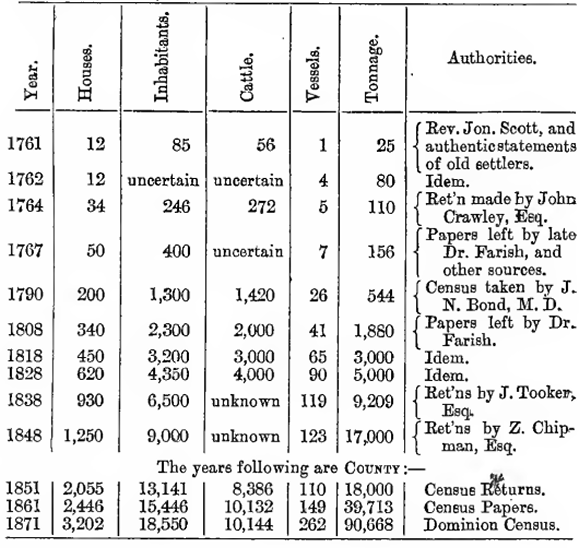
to N. K. Clements,
Esq., who has proved himself, amidst discouraging circumstances, the
unwearying promoter of the public interests of his native Town. The
first steamer that was ever seen in this harbour was the “ Saxe Gotha,”
in 1842. And unbroken steam communication by land we shall soon enjoy.
The Westeen Countres Railway Company was incorporated in 1871. In
September 1873 the first contract was made ; and since then, the
Township has become interested in one way and another, to the -extent of
about $400,000, and the Dominion Government, as well as the Local
Legislature, have aided a work, which, however opinions may vary as to
what would have been the route best calculated to develope the future
interests of the County generally, is yet one in which every inhabitant
is deeply interested. Considering the difficulties which had to be
encountered, the progress which has been made in the work is
characteristic of the people who promote the undertaking. On September
3rd, 1874, the first rail was laid; on the 20th of the following month,
the Pioneer,— the first Locomotive arrived; and, in less than a month
from that date, the road was in working order, as far as Hebron. The
trial trip made a few days after the engine arrived is thus described in
the Herald, the account in which is more suited for these pages, than
that in its more imaginative and poetical contemporary—the Teribune -
“The Locomotive 1 Pioneer, 5 having been put in working order, made a
short trial trip on Tuesday afternoon, accompanied, of course, by its
tender. The 'train,’ crowded with passengers, started from the terminus
near the head of Lovitt’s wharf, and proceeded about two miles, or a
short distance above Milton, when it returned to the starting point.
Throngs of persons, of both sexes, lined the route, enthusiastically
cheering, waving handkerchiefs, &c., while the ‘Pioneer’ responded by
the ringing of the bell and occasional blasts of the whistle. Horses,
who were spectators of the unusual scene, did not like the appearance
nor the neighing of the ‘iron horse,’ whom they evidently regarded as an
intruder, and were with difficulty restrained from putting their own
locomotive powers to the test, whilst cattle bounded off in every
direction from the track, and even the domestic fowls scampered off to
their respective domiciles with an energy that was amusing to witness.”
The difficulties which threatened to interfere with the continued
progress of the works on the Railway were happily overcome by the well
known Montreal firm of Shanly & Plunkett assuming in October 1875 all
the responsibility attached to the carrying of the work through to a
successful issue. The officers of the Company and the Contractors met in
Halifax in the November following, and then completed all their
arrangements. The line will probably not terminate short of a point
which will admit of continuous steam traffic, summer and winter, by land
and water.
There is a County interest of the first moment, upon which we have but
touched—I mean the Fisheries.
Making every allowance for the apocryphal tales of the good old times
when the Tusket was so full of salmon, that the only way the fish could
get up the river, was over each other’s backs; there is no doubt but
that carelessness and other causes have very greatly injured many of the
river fisheries. Under the new act of 1868, there is however a very
marked improvement already. In the one article of salmon the yield of
which in 1869 was 4,000 lbs.; there has been an increase of 5<3o per
cent.; the yield in 1873 having been about 20,000 lbs.: and the value of
all the fish,* fresh water and salt,—caught in the County in that year,
was about $450,000.
Reference to the fisheries suggests some notice of
OUR HOME AND FOREIGN TRADES.
Since the year 1787 when Yarmouth was made a Port, and when the duties
were scarcely appreciable, the business of the County has steadily
increased. The gross Imports amount to about $700,000, the principal and
most valuable part of which consists of materials for fitting and
furnishing ships. The gross annual Exports, which consist chiefly of
Lumber and Fish, amount to about $300,000. Looked at in this way, we are
placed in the apparent position of being improvident and extravagant,
inasmuch as we seem to consume more than we produce. But if, as is at
once fair, and necessary for getting at the truth, the annual production
of vessel property he brought into the account, as a hind of export,—
allowance being made for the value of the imported material, such as
rigging and the like, — the amount of property annually sent out of the
Port, amounts to about $1,500,000.
One little item illustrating the increasing home trade, as well as the
altering condition of our social life, is the fact that about the year
1799 the then collector imported half a chaldron of coal, the first
brought into the County ; and in 1875 the amount imported was over
twelve thousand tons.
RECAPITULATION.
The past history of this County is one of progress. We have seen
eighty-five souls become well nigh twenty thousand; and the one little
schooner of 25 tons has yielded to a fleet of upwards of 250 vessels,
representing a total of more than 130,000 tons : a tonnage more than
eighty times that of Liverpool, England, and nearly one half the tonnage
of the whole kingdom, in the reign of Charles the second.
We have seen intricate Indian trails and crooked cow-patks give place to
numerous highways, well made, graded and levelled, intersecting the
County in every direction. From there being but a few barley and potatoe
patches, surrounded by unbroken forests, we see around us upwards of
fifty thousand acres of improved lands. We have seen a share of land
containing six hundred and sixty-six acres, sold for £10, and we have
lately heard of a piece of ground less than a hundred feet square being
sold for $6000: the aggregate value of . all property, real
and-personal, in the Township of Yarmouth alone, being probably well
nigh ten millions of dollars.4 We have seen the inhabitants obliged to
go p hundred miles to register a deed, or try a cause, and that without
any kind of road, and now their descendants have every such convenience
at their very doors. From scarcely any but the most precarious means of
communication with even Halifax or St. John, not to mentiou England, we
see several daily mails brought in from all parts; and by means of the
electric telegraph we can be in hourly communication with the most
distant countries.
And still the march is onward. Institutions indicative of industry,
perseverance, and enterprize, are ever springing into life, affording,
if necessary, additional substantial evidence of public and private
intelligence. Ere long, land communication by steam will add to, or
rather complete, our convenience for travelling, whilst it will develop
interests as yet not fully appreciated, only because not fully
understood. One word in
CONCLUSION.
In undertaking this work, I have permitted my sympathies to go out far
beyond the comparatively narrow limits of those with whom I am more
immediately associated, and whom it is my more immediate duty to serve.
But I have learned to take an interest in whatever affects the wellbeing
of the whole. I now leave the subject, which was not undertaken too
soon, as the obituary columns of the local press will testify, by
expressing the fervent hope that the same good qualities which has
served to elevate this community, may continue increasingly active; that
the evil which is absent, and which would mar our character and
reputation, may never come near us; that we may remember and acknowledge
the fact, that if we are prosperous, it is God that giveth us power to
get wealth; that we may ever be just and true in all our dealings, for
it is righteousness alone that exalteth a people; that our magistrates
may ever have grace to execute justice and maintain truth; that our
politicians may be fearlessly honest and not to be corrupted; and that
the ministers of religion may ever be ready to speak the truth: for, by
these means only can we reasonably hope that “peace and happiness, truth
and justice, religion and piety, may be established among us for all
generations.”
FINIS |
